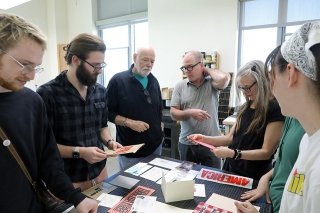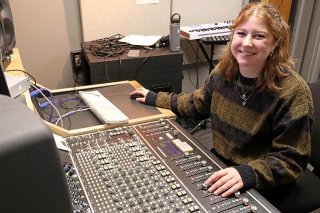Students Experience Printing the Old-Fashioned Way
Posted:

Today, when you want something printed, it’s as easy and convenient as typing on a computer and sending it to a printer.
Beginning this semester, Bloomsburg graphic design students are getting experience in printing as it was done a hundred years ago. In the process they are getting a new appreciation for design.
James Dunlap, associate professor of art and art history, installed a letterpress in the university’s art studios. The press is a gift from Ernie Blitzer, a friend of Dunlap’s who retired in South Carolina from a decades-long career in printing and advertising. Dunlap and Chad Andrews, associate professor of art and art history who teaches printmaking, drove down to South Carolina over the winter break to move and install the donated letterpress and dozens of cases of metal type.
“Students have spent their lives typing on a device,” says Dunlap. “This historical approach gives students better understand working with typography and the history of graphic design. It also offers a more traditional, hand-made aesthetic than the computer offers.”
A letterpress uses individual metal castings of letters, arranged in lines to print pages. The term “leading” used for the space between lines in graphic design today comes from the thin strips of metal used to create space between lines of metal letters.
To create a page for printing, Dunlap’s students arrange the individual letters in mirror image lines in a frame called a “galley” — another printing term that has found new life as a term for a proof of project. Once the metal type is arranged, the students roll ink on the letters. They place paper on the inked letters and move the entire assemblage under a large metal roller that presses the paper into the inked metal.
The letterpress will allow a new course “Letterpress Printing” to be offered in the Fall 2023 semester. “The world we live in is dominated by the digital landscape,” says Dunlap. “The letterpress offers a different view of the production of writing. There still is a market for letterpress work more formal design such as wedding invitations, thank you notes, and formal letters. It offers the opportunity to create something with a more special meaning behind it.”
“It’s not the fastest way to produce text but it’s more about the tactile feel and thought that goes into it,” says Dunlap. “I enjoy the change from working digitally. It’s nice to work slowly, and you really think through what you want to print and how to go about it.”
“You have to think and pick a font very intentionally. You can’t just change it at the touch of a button, like you would on a computer. The goal is to have the students think more critically about how the text is placed onto the page. This has all the potential to help students in their design and typography skills.”



